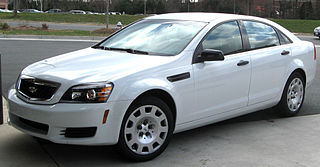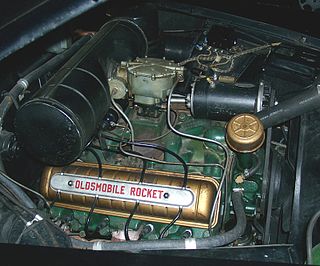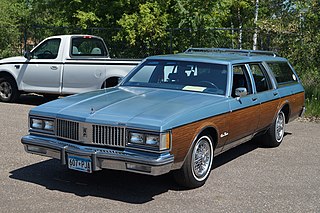
The Chevrolet Impala is a full-size car that was built by Chevrolet for model years 1958 to 1985, 1994 to 1996, and 2000 to 2020. The Impala was Chevrolet's popular flagship passenger car and was among the better-selling American-made automobiles in the United States.

The Chevrolet Caprice is a full-size car produced by Chevrolet in North America for the 1965 to 1996 model years. Full-size Chevrolet sales peaked in 1965 with over a million sold. It was the most popular car in the U.S. in the 1960s and early 1970s, which, during its lifetime, included the Biscayne, Bel Air, and Impala.

The Chevrolet Bel Air is a full-size car produced by Chevrolet for the 1950–1981 model years. Initially, only the two-door hardtops in the Chevrolet model range were designated with the Bel Air name from 1950 to 1952. With the 1953 model year, the Bel Air name was changed from a designation for a unique body shape to a premium level of trim applied across a number of body styles. The Bel Air continued with various other trim level designations, and it had gone from a mid-level trim car to a budget fleet sedan when U.S. production ceased in 1975. Production continued in Canada, for its home market only, through the 1981 model year.

The Pontiac Catalina is a full-size, junior series automobile produced by Pontiac from 1950 to 1981. Initially, the name was a trim line on hardtop body styles, first appearing in the 1950 Chieftain Eight and DeLuxe Eight lines. In 1959, it became a separate model as the "entry-level" full-size Pontiac.

The Pontiac Bonneville is a model line of full-size or mid-size front-engine rear drive cars manufactured and marketed by Pontiac from 1957 until 2005, with a hiatus for model years 1982-1986.

The Oldsmobile V8, also referred to as the Rocket, is a series of engines that was produced by Oldsmobile from 1949 until 1990. The Rocket, along with the 1949 Cadillac V8, were the first post-war OHV crossflow cylinder head V8 engines produced by General Motors. Like all other GM divisions, Olds continued building its own V8 engine family for decades, adopting the corporate Chevrolet 350 small-block and Cadillac Northstar engine only in the 1990s. All Oldsmobile V8s were manufactured at plants in Lansing, Michigan while the engine block and cylinder heads were cast at Saginaw Metal Casting Operations.

Buick Estate is a nameplate that was used by the Buick division of General Motors, denoting its luxury full-size station wagon from 1940 to 1964 and from 1970 to 1996. The Estate nameplate was derived from the term country estate in wealthy suburban areas and estate car, the British term for a station wagon.

The Oldsmobile Custom Cruiser is an automobile that was manufactured and marketed by Oldsmobile from 1971 until 1992. Marking the return of Oldsmobile to the full-size station wagon segment, the Custom Cruiser was initially slotted above the intermediate Oldsmobile Vista Cruiser, ultimately above the later mid-size Oldsmobile Cutlass Cruiser.

The Pontiac Parisienne is a full-size rear-wheel drive vehicle that was sold by Pontiac on the GM B platform in Canada from 1958 to 1986 and in the United States from 1983 to 1986. Right-hand drive models were locally assembled in Australia, New Zealand, and South Africa until 1969. For most of its run, the Canadian Parisienne was nearly mechanically identical to the American Chevrolet Impala or Chevrolet Caprice. The Parisienne wagon continued under the Safari nameplate until 1989. Parisienne or La Parisienne means a grammatically female person or thing from Paris, France.

The Pontiac Safari is a line of station wagons that was produced by Pontiac from 1955 to 1989. Initially introduced as the Pontiac counterpart of the two-door Chevrolet Nomad, the division adopted the nameplate across its full-size wagon range in 1957. Through its production, the Safari was positioned between Chevrolet full-size station wagons and below its Buick and Oldsmobile counterparts. During the mid-1960s, the Safari added simulated woodgrain trim to the exterior, becoming a feature associated with the model line.
Arlington Assembly is a General Motors automobile factory located in Arlington, Texas. The plant has operated for more than 60 years and today manufactures large SUVs from GM's divisions Chevrolet, GMC and Cadillac.

The Chevrolet Brookwood is a series of full-size station wagons produced by Chevrolet from 1958 to 1961, and again from 1969 to 1972. It debuted in 1958 as Chevrolet's mid-range model in its station wagon lineup, positioned between the less expensive Yeoman and more luxurious Nomad station wagons. After the Yeoman was discontinued in 1959, the Brookwood was subsequently demoted to entry-level status, before going out of production altogether in 1961. It made a brief reappearance from 1969 and 1972, once again as the least-expensive wagon in Chevrolet's lineup.
Linden Assembly was a General Motors automobile factory in Linden, New Jersey, United States. The plant operated from 1937 to 2005 and made cars, trucks and SUVs for various GM automotive divisions.

Chevrolet Nomad is a nameplate used by Chevrolet in North America from the 1950s to the 1970s, applied largely to station wagons. Three different Nomads were produced as a distinct model line, with Chevrolet subsequently using the name as a trim package.
The GM A platform was a rear wheel drive automobile platform designation used by General Motors from 1925 until 1959, and again from 1964 to 1981. In 1982, GM introduced a new front wheel drive A platform, and existing intermediate rear wheel drive products were redesignated as G-bodies.

The Pontiac Grand Safari was Pontiac's top-of-the-line full-size station wagon offered from 1971 to 1978. The Grand Safari used the grille and interior trim of the Bonneville and Grand Ville passenger car series, and most examples were trimmed with woodgrain paneling on the sides and tailgate.

Oshawa Assembly is a manufacturing facility in the city of Oshawa, Ontario, Canada, that built various automobiles for General Motors Canada.
The Chevrolet Kingswood was a 4-door station wagon produced by Chevrolet in 1959 and 1960, and again from 1969 to 1972 built on the GM B Body platform.

The fifth generation of the Chevrolet Impala is a line of full-size cars produced by Chevrolet from the 1971 to 1976 model years. The largest generation of the model line, the fifth-generation Impala grew to a 121.5-inch wheelbase
This is a list of automobiles produced for the general public in the North American market. They are listed in chronological order from when each model began its model year. If a model did not have continuous production, it is listed again on the model year production resumed. Concept cars and submodels are not listed unless they are themselves notable.
















